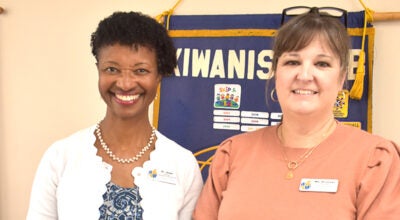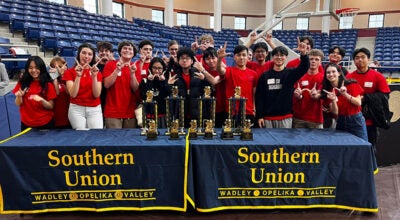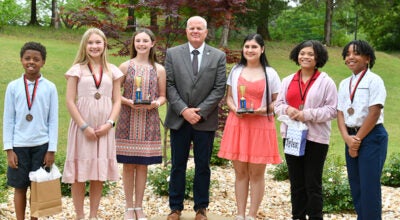Valley native talks about climbing Mt Everest
Published 9:54 am Wednesday, March 16, 2022
|
Getting your Trinity Audio player ready...
|
VALLEY — Hugh Morton and Lapka Rita stood together on the top of Mount Everest on May 15, 1992. Last week they were together again to present a program on their mountaineering experiences at Bradshaw-Chambers County Library. A large crowd gathered inside the Lanier Room to hear them.
Attendees heard the two men speak, watched a PowerPoint presentation about the Sherpa people of the Himalayas and saw a video of Morton’s Seven Summits achievement. In 1999, Morton became the 67th person to reach the summit on the tallest mountain on each of the earth’s seven continents. Seven years earlier he became the first person from the Southeastern U.S. to reach the top of Everest, the world’s highest peak.
Morton is a Valley native and a graduate of Valley High and Auburn University. He and wife Ellen currently reside in Fayetteville, Georgia and have a second home near West Point Lake. Morton thanked Librarian Mary Hamilton and her staff for arranging the program.
“This is a first-class library,” he said. “Mary and her staff do a great job.”
Morton said he’s often asked what it takes to climb a mountain.
“First of all you have to have a wife that will consent to that foolishness,” he said half jokingly.
It’s also important to connect with others who have done it before and to learn from them.
“Mike Stewart is one of my best friends,” he said. “He had been climbing mountains ten years before I started. He has climbed the highest peaks in all 50 states.”
The Sherpa people have lived in the Himalaya region for hundreds of years. They managed a hard life in an area with harsh winters, meager resources, no schools and primitive heath care. Transportation was hard with goods being carried on pack animals. In the late 1800s, explorer George Everest (for whom the mountain is named) took photos of them and told their story to the western world.
One thing the Sherpa became very good at was climbing mountains. It was something they had to do to survive. The best-known Sherpa is a man named Tenzing Norgay (1914-1986). In 1953, he became world famous when he and Englishman Edmund Hillary became the first to reach the top of Mount Everest. He was the first person to be photographed on the summit. The United Kingdom had a young queen named Elizabeth II at the time.
Rita said that Norgay has always been a heroic figure to him and is greatly admired by the Sherpa people of Nepal. For years, he was the de facto spokesman for them. That role is now being carried on by Rita, who has guided mountaineers on Everest expeditions more than 30 times and has reached the summit 18 times.
“He’s one of the strongest, most capable mountaineers in the world,” Morton said.”He has come a long way to help me promote my book.”
At the end of the program, Morton signed copies of “Reflections on High Places.” Proceeds from the book will help the Sherpa people. Nepal is one of the poorest countries in the world. It’s difficult to provide schools for the Sherpas. Morton helped one of his mountaineering friends, Todd Burleson, build a school in the region.
When Rita was young it took a four-hour walk to get to the nearest school from his home.
“I could say a lot about Rita,” Morton said in introducing him. He’s been guiding climbers for 38 years, adding to some laughter,
“He’s been leading them up the really big ones, not Pine Mountain.”
Rita, 57, is living in the Seattle area now.
“He’s retired from the hard stuff but will do some free learning climbs,” Morton said. “He’s a very strong person. I am amazed at the things he has done. He’s a quiet, humble person but one of the most congenial people I have ever known.”
Rita thanked the crowd for coming to hear him speak. He said that both great things and sad things had happened in his life. He was one of ten children being raised by parents in a remote region of the Himalayas.
“Six of us are still living,” he said. “My dad was a mountain guide. We were fortunate to have had a school built for our people by Edmund Hillary, but it took four hours on foot to get there and four hours to return. There was no electricity in our home. We had to read by kerosene lamps. Hillary built us a hospital, too.”
Six boys in the family had the chance to go to school. The four girls stayed at home to gather firewood, cook meals and tend their yaks. One of Rita’s brothers was a monk f0r a time but later decided to follow the family tradition and be a mountain guide.
“Tenzing Norgay is my hero,” he said. “I’ve always wanted to follow in his footsteps.”
Rita’s first expedition took place in 1984. He’d had only one week of training at base camp.
His most harrowing experience was being with a group that got caught up in an avalanche in 2014. There were 15 Sherpa on the climb and five of them died. Rita was at base camp at the time.
“We got a call on the radio that some Sherpa needed help,” he recalled. “I got my gear together, put my boots on and made sure all of us who were going to help them had water and tools to help get them out.”
News of the tragedy traveled fast.
“On the way, I got a call from my wife asking me if I was okay,” he said. “I told her not to worry, that I was alright but couldn’t talk for long. I had work to do.”
Rita said the Sherpas saw the avalanche coming, but there was nothing they could do to get out of the way.
“When we got there, two of them were looking for the others,” he said. “We dug out 11 bodies that day, got them back to base camp and sent messages to their families.”
Rita said it was especially hard to talk to children about what had happened.
“It was just bad timing,” he said of the tragedy.
He was one of the fortunate ones to survive, but losing five members of the party was tough to deal with.
“I considered not going back to do this,” he said, “but from where I’m from there’s little else to do.”
Rita said he feels fortunate to have learned to speak English and to have made good friends like Burleson and Morton.
There’s a sense of satisfaction and accomplishment in helping people to the top of the world’s highest mountain. Rita has helped over 250 people get there.





